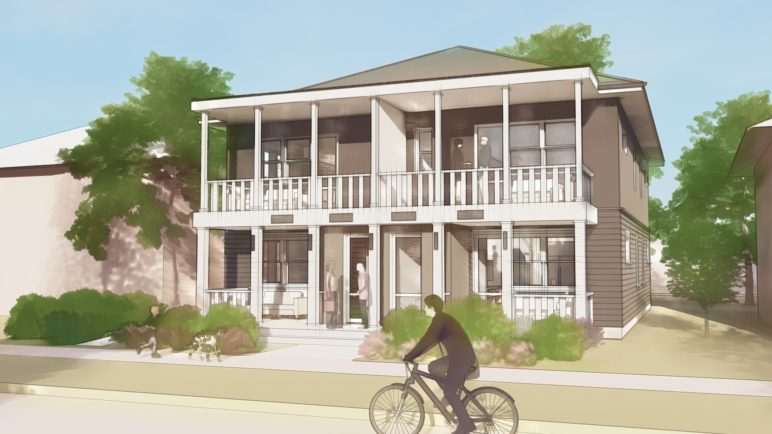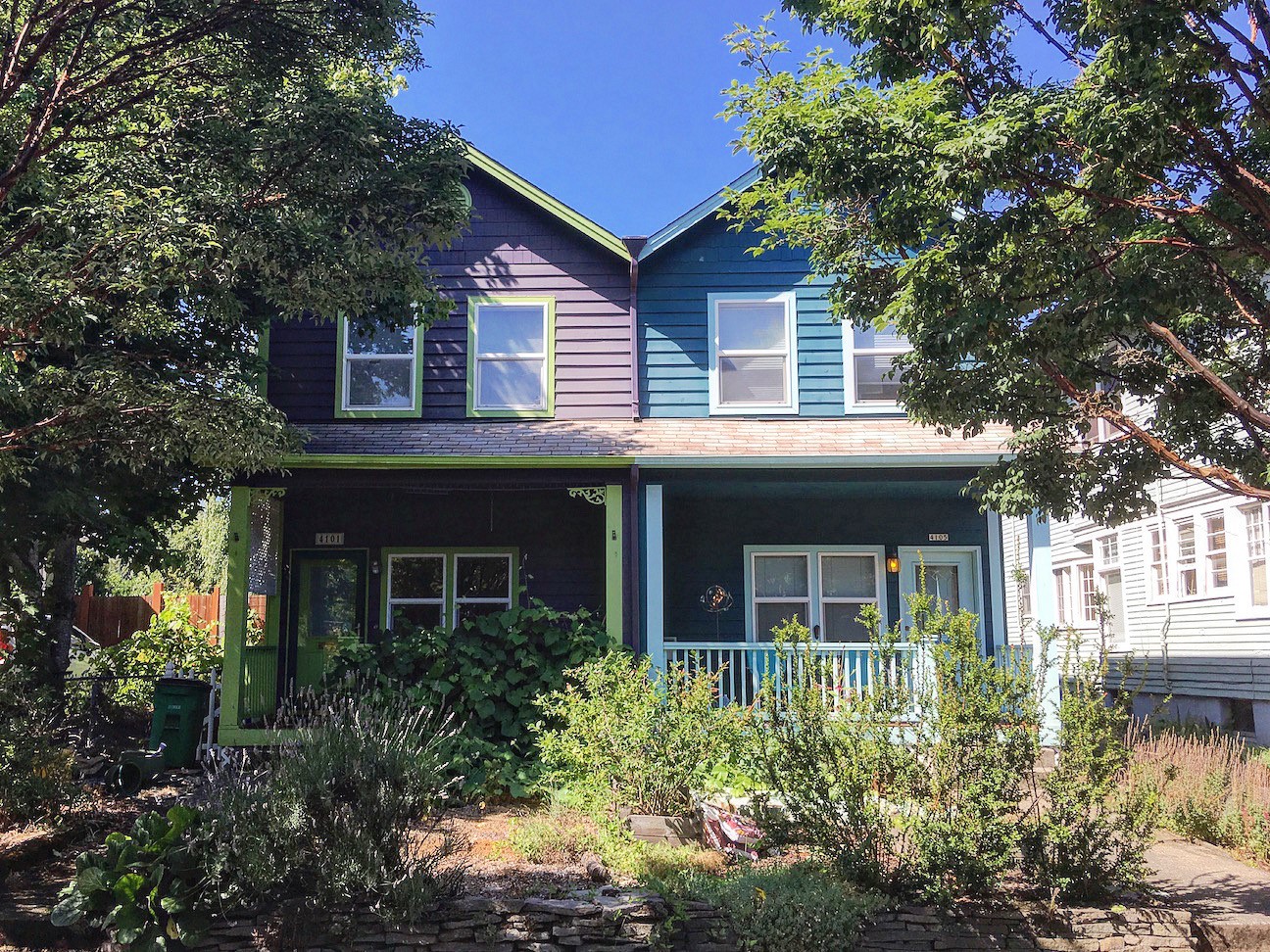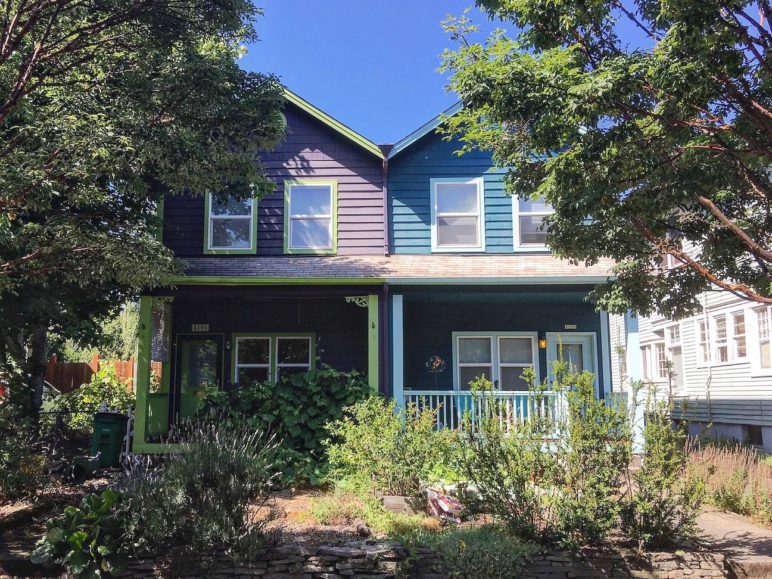UPDATE 05/08/23: Governor Jay Inslee signed HB 1110 into law!
UPDATE 04/11/23: HB 1110 passed the Senate on a bipartisan vote of 35 – 14, next step, the Governor’s desk! Previously, the Ways & Means Committee made one major change to the bill, adopting a striking amendment that reduced the requirement from fourplexes to duplexes for cities with population of 75,000 or less. Here’s what the passed bill does:
- Cities > 75,000: fourplexes everywhere; sixplexes < ¼-mile of major transit stop or if two units are affordable
- 25,000 < Cities < 75,000: duplexes everywhere; fourplexes < ¼-mile of major transit stop or if one unit is affordable
- Cities < 25,000 and in UGA contiguous with the largest city in county > 275,000: duplexes everywhere
- Alternative compliance path: 75 percent of lots must allow the densities above, with limitations:
- The excluded 25 percent must include all environmentally critical areas, and all areas delaying the bill’s implementation based on displacement risk or lack of infrastructure
- The excluded 25 percent may not include any areas that had historic exclusionary covenants, or areas where retention of existing zoning would exacerbate racially disparate impacts
- Lifts parking mandates < ½-mile of major transit stop
- Caps parking mandates at one space per unit on lots < 6,000 sq.ft.
- “Major transit stop” is defined as light rail, commuter rail, and bus rapid transit
- “Affordable housing” is defined as affordable to 60% of area median income for rental, and 80% of AMI for ownership
UPDATE 03/06/23: HB 1110 passed the House on a 75 -21 vote, and now heads to the Senate. The bill remains strong, although floor amendments weakened it slightly. Here is what the bill now does:
- In cities with population of 75,000 and above, it legalizes fourplexes everywhere, and sixplexes within a quarter-mile of a major transit stop, or if two of the units are affordable
- In cities within an urban growth area contiguous with the largest city in any county with population of at least 275,000, two options:
- same allowances as those above, or;
- triplexes everywhere, fourplexes if one of the units is affordable, and sixplexes within a half-mile of a major transit stop
- In cities with population between 25,000 and 75,000, duplexes everywhere and triplexes if one of the units is affordable
- Lifts parking mandates within a half-mile of a major transit stop (rail and bus rapid transit) for cities in all three of the above categories
- No longer legalizes additional units per lot near “community amenities”
Will 2023 be the year that Washington state opens up more housing options for families and individuals here? The year it joins other West Coast states to end widespread bans on every kind of home except detached houses with big yards?
Legislators tried last year, and this year are back with another bill, HB 1110, to lift local zoning laws that ban multi-dwelling homes like duplexes and townhouses. It would open the doors to “middle housing” options for hundreds of thousands of families, legalizing up to fourplexes all on residential lots in most cities, and sixplexes near transit stops.
By legalizing more housing options in neighborhoods throughout the state, the bill would not only help correct the historic injustice of restrictive zoning originally enacted to exclude Black families, but also relieve the root cause of Washington’s housing crisis: a shortage of homes.
More middle housing means more affordable home choices near jobs, schools, and transit, and more options for first-time homebuyers. It also means a wide range of other benefits to Washingtonians, including less sprawl into our farmland and forests, more walkable communities, reduced home energy use, lower municipal infrastructure costs, jobs for small, local builders, and increased local tax revenue.
How middle housing can ease the housing shortage
Washington officials project that the state will need roughly one million new homes by 2044. The pro-housing nonprofit group Up for Growth estimates the state’s shortage of homes rose from 64,000 in 2012 to 140,000 in 2019—more than doubling in just 7 years.
Compared with typical apartment buildings, middle housing yields fewer homes per lot, but there’s power in numbers: Washington has about 1.8 million detached houses occupying roughly three-quarters of the state’s residential land. If middle housing were legalized, only a fraction of those house lots would gain new homes, but that small share would still be enough to help pull Washington out of its housing shortage.
Extrapolating from a California study, legalizing fourplexes throughout Washington could make more than 200,000 more homes not only legal, but also financially feasible for builders to construct.
A University of Washington report estimated that legalizing fourplexes within a quarter-mile of transit stations would create capacity for nearly half a million more homes in the Puget Sound region, which houses 4.3 million of the state’s 7.6 million residents. If even a fifth of that capacity eventually saw construction, that’s 100,000 more homes in the Puget Sound region alone.
Detailed projections are not available for the 2023 middle housing bill, but we know that it will legalize the potential for hundreds of thousands more homes for individuals and families that need them all across the state.

Fourplex with two-bedroom units that fits on a typical 50 x 120-foot single-family lot, designed by Cast Architecture.
Breaking down HB 1110, WA’s 2023 middle housing bill
Continuing her strong leadership on housing, Representative Jessica Bateman is the prime sponsor of this year’s bill, HB 1110, that would legalize middle housing in two tiers:
- Within a half-mile of frequent transit,1 up to six homes per lot
- In cities with a population of 6,000 or more, or cities of any size within the contiguous urban growth areas surrounding Seattle or Spokane, up to four homes per lot
Applies to small cities located within major metros
A key change from the 2022 bill is that fewer cities would be exempted based on population. The bill applies to cities as small as 6,000 (the cutoff in last year’s bill was 20,000).
In addition, cities smaller than 6,000 will not be exempt if they lie within an urban growth area contiguous with a city that has population of at least 200,000, which translates to the Seattle and Spokane metros. This would ensure that small cities in major metros do their fair share in allowing more housing near the state’s biggest job centers (take, for example, Seattle-area enclaves Medina or Yarrow Point).
Grants an allowance for sixplexes if two homes meet affordability requirements
A second key update to the new bill is a boost in the allowance from four to six homes per lot if the two extra homes are offered at a price or rent affordable to households earning 80 percent of the area median income. This option would incentivize affordable housing without the risk of affordability mandates making fourplexes financially infeasible to build.
Reduces or eliminates costly parking mandates
One critical provision in the bill is a limit on parking mandates. Parking mandates not only inflate the cost of homes, but in the case of middle housing, they can be especially problematic for efficient design because of how much of a lot’s square footage they swallow up.
For middle housing within a half-mile of frequent transit—areas that WSDOT estimates encompass 20 percent of the state’s population—the bill would lift all parking mandates.
Elsewhere, it would cap mandates at no more than one parking stall per lot on lots 6,000 square feet or smaller, and at no more than two stalls per lot on lots larger than that.
Requires anti-displacement safeguards
To protect existing communities from displacement pressures that could be exacerbated by middle housing reforms, for areas within a half-mile of transit, HB 1110 would require that cities preemptively take the actions defined by a 2021 bill that established new anti-displacement standards for local planning.
Overall, legalizing middle housing is in itself an anti-displacement measure, because the additional homes it allows help reverse the cause of most displacement: prices and rents propelled skyward by the statewide housing shortage. Also, the option to add two extra homes per lot if they are rent-regulated will help provide more options affordable to existing community members.
Provides flexibility and support for local governments
Cities would retain control over siting and design as long as the rules are objectively defined2 and aren’t any more restrictive that those that apply to detached houses. But the bill would also set a “reasonableness standard” to prevent local restrictions that would render middle housing all but impossible to build, even if technically legal.
Cities enacting the required zoning reforms would be immune from appeals and lawsuits on those actions under the State Environmental Policy Act or Growth Management Act. Cities would have two years to adopt the bill’s requirements, and those with unusual infrastructure limitations could apply for delayed implementation.
The bill directs the Department of Commerce to provide technical assistance to cities, including a model ordinance for middle housing. The state previously offered support to cities on middle housing through planning grants created by the 2019 bill HB 1923, and it does so currently through grants established by a 2022 budget proviso.
Washington can end its ugly legacy of exclusionary zoning
The best time to stop exclusionary zoning and all its harmful effects would have been a century ago. The next best time is now—that is, in the 2023 Washington legislative session. Passing the middle housing bill would create more housing choices in more neighborhoods that more Washingtonians can afford. And it would also undo the ugly historic legacy of zoning designed to segregate.
CORRECTION: A previous version of this article stated that a half-mile radius around all of the state’s transit stops that meet the bill’s definition of frequent transit would encompass 39 percent of the state’s population. The correct figure is 20 percent.
Download a cheat sheet explaining 18 reasons why Washington should legalize middle housing. Sign up here for action alerts and legislative updates.











RL
The footnote links just go back to the top of the article…
Webster Chang
Hi RL! Are you left-clicking the footnotes? They appear as a scripted dropdown rather than another page. If you are still having trouble, let me (webster@sightline.org) know and I’m happy to see what I can provide
Rebekah
Is there any limitation on taxation at highest and best use in the bill? Are you aware of any data about property tax impact to ALL landowners?
Dan Bertolet
Washington’s 1 percent cap on the annual increase in property tax revenue means that property value increases on upzoned land would be offset by a reduction in property taxes on unaffected land.
Mike miller
https://www.cato.org/commentary/density-makes-housing-less-affordable-not-more
There are studies after studies of zero linkage between increased density and affordability. As a builder myself. There is no housing crisis only people chasing profit.
Otar the Foul
Actually the root cause of the current housing crisis is housing being bought up by big institutional investors. Which this bill will do nothing to fix that problem, and will just give those big institutional investors more homes they can buy.
Dan Bertolet
The evidence I’ve seen does not support you claim, for example:
https://www.theatlantic.com/ideas/archive/2021/06/blackrock-ruining-us-housing-market/619224/
Jim Lazar
Once again, Dan Bertolet misses the mark on housing and the quality of life.
Subsidizing developers and builders with discounts on impact fees, laissez-faire approaches to zoning, and ever-increasing density is not a solution that provides for a high-quality community.
Developing new housing density without adequate parking creates safety issues and air pollution, and people drive around the block, often angrily, looking for a place to park. I’ve experienced that in Seattle, and don’t want it coming to my neighborhood.
Doing density right ensures that there is adequate provision for housing, parking, neighborhood shops, and for parks and open space. Simply mandating that “every lot” can have four dwellings will make everyplace feel like Federal Way. We don’t all want to live in Federal Way.
https://www.densitydoneright.org/
Mike Hemmerly
I agree with your concerns about a lack of parking mandates. In many neighborhoods that would create parking hell. Our legislators and voters need to be aware of the impact of this particular item of HB110.
Dan Bertolet
Jim and Mike –
Don’t know what to tell you other than Sightline’s research makes it abundantly clear that public policy should prioritize housing for people over storage for cars.
– Dan
Sobrado
Which is nonsense as most communities affected, some a good 20 to 40 miles away from Seattle do not support car free living at all nor will they ever in our lifetimes as services are simply too far and WA is notorious for lack of pedestrian friendly infrastructure like sidewalks. So people will still buy cars but clog streets. As always clueless urbanists fail to realize how people actually live nor do they visit the places these bad politics will hurt. Developers will clog our roads and it will be a hell scape of terrible living conditions to anyone stuck in these rat nests of urban planning.
Debbie Braz
They don’t intend for us to be using automobiles at all soon. They want all walkable, cyclable areas and public transportation of varying types. They had some 15-minute cities somewhere in Europe that had the people up in arms as to all the restrictions to their normal living and being able to travel freely from district to district. All are part of the United Nations Agenda 21, 2030, and 2050 to survey, inventory, and control every living thing on the planet. All under the guise of “climate change” “racial equity” and so on.
Heidi Venture
I wish this bill included smaller towns. We’re trying to build a triplex in White Salmon, Washington, which is too small to be affected. Dang.
Benfield
Is there a discussion of how this will affect HOAs and their restrictive covenants? It mentions governmental jurisdictions, but I don’t immediately see how this would prevent each neighborhood from creating an HOA and covenant that prevents additional density.
Ken Davis
This is a giveaway to developers, real estate agents, and corporations that tear down cheap housing and put up buildings for tech bros. This will increase pollution and global warming, and remove home ownership from individuals and transfer it to corporations.
The photo on your article is a deceptive lie. No 2 plex or 4 plex I’ve seen in Seattle looks like this. Every one I’ve seen in the U distrcit/ Greenlake/ Wallingford area has chopped down all trees and vegetation, paved or cemented or every inch of land, blocked out sunlight from neighbors growing a garden or having solar electrical generation, and built up to the property line with a large, heat retaining building. All the previous housing materials were expensively hauled off to fill up landfills in Oregon.
Why aren’t you advocating for keeping existing structures, but allowing and financing support to allow more people to live in a home? Oh, I know, I know! You don’t get any money from those type of existing houses, whereas you get amazing support from developer, right?
The house across the street from me was made decades ago into separate apartment rooms, with 8 people living in this one structure. THIS could be a model that expands density, while preserving the environment.
NO to this anti environmental bill that will benefit the wealthy, and tear down existing low income housing!
Utet
Does this mean that RSA zones which are single family can now be rented out with roommates?